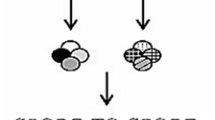Abstract
Fermentative behaviour and cell growth have been studied in grape juice inoculated either with two killerSaccharomyces cerevisiae wild strains or with their Acridine Orange-cured isogenic counterparts. The number of viable cells/ml at the beginning of the fermentation, as well as during exponential growth, were higher in grape juices inoculated with the cured strains. The CO2 production, fermentative rate and ethanol and acetic acid production were also higher in the cured strains, particularly during the stage of active fermentation. These differences, however, were minimal at the end of the fermentations.
Similar content being viewed by others
References
Bussey, H. & Sherman, D. 1973 Yeast killer factor: ATP leakage and coordinate inhibition of macromolecular synthesis in sensitive cells.Biochimica et Biophysica Acta298, 868–875.
Cansado, J., Longo, E., Agrelo, D. & Villa, T.G. 1989 Curing of the killer character ofSaccharomyces cerevisiae with acridine orange.FEMS Microbiology Letters65, 233–238.
Cansado, J., Longo, E., Calo, P., Sieiro, C., Velazquez, J.B. & Villa T.G. 1991 Role of killer character in spontaneous fermentations from NW Spain: ecology, distribution and significance.Applied Microbiology and Biotechnology34, 643–647.
De la Pena, P., Barros, F., Gascon, S., Lazo, P.S. & Ramos, S. 1981 Effect of yeast killer toxin on sensitive cells ofSaccharomyces cereviseae. Journal of Biological Chemistry256, 10420–10425.
Fried, H.M. & Fink, G.R. 1978 Electron microscopic heteroduplex analysis of “killer” double-stranded RNA species from yeast.Proceedings of the National Academy of Science of the United States of America75, 4224–4228.
Herring, A.J. & Bevan, E.A. 1974 Virus-like particles associated with the double-stranded RNA species found in killer and sensitive strains of the yeastSaccharomyces cerevisiae.Journal of General Virology22, 387–394.
Houtman, A.C. & Du Plessis, C.S. 1985 Influence de cépage et de la souche de levure sur la vitesse de fermentation et sur la concentration des composants volatils du vin.Bulletin de L'Office International de la Vigne et du Vin,648–649 235–246.
Kitano, K., Sato, M., Shinazaki, T. & Hara, S. 1984 Occurrence of wild killer yeasts in Japanese wineries and their characteristics.Journal of Fermentation Technology62, 1–6.
Longo, E., Velazquez, J.B., Cansado, J., Calo, P. & Villa, T.G. 1990 Role of killer effect in fermentations conduced by mixed cultures ofSaccharomyces cerevisiae.FEMS Microbiology Letters71, 331–336.
Longo, E., Cansado, J., Agrelo, D. & Villa, T.G. 1991 Effect of climatic conditions on yeast diversity in grape musts from northwest Spain.American Journal of Enology and Viticulture,In press.
Maniatis, T., Frisch, E.F. & Sambrook, J. 1982Molecular Cloning. A Laboratory Manual. Cold Spring Harbor NY: Cold Spring Harbor Laboratory.
McKover, M. & Bevan, E.A. 1963 The inheritance of a killer character in yeastS. cerevisiae.Proceedings of the International Congress of Genetics XI,1, 202.
Naumova, T.I. & Naumov, G.I. 1973 comparative genetics of yeast. XII. Study of antagonistic interrelations inSaccharomyces yeast.Genetika9, 85–90.
Palfree, G.E. & Bussey, H. 1979 Yeast killer toxin: purification and characterization of the protein toxin fromSaccharomyces cerevisiae.European Journal of Biochemistry93, 487–493.
Philliskirk, G. & Young, T.W. 1975 The occurrence of killer character in yeast of various genera.Antoine van Leeuwenhoek Journal of Microbiology and Serology41, 147–151.
Somers, J.M. & Bevan, E.A. 1969 The inheritance of the killer character in yeast.Genetical Research13, 71–83.
Stumm, C., Hermans, J.H.M., Middelbeek, E.J., Croes, A.F. & De Vries, G.J. 1977 Killer-sensitive relationships in yeast from natural habitats.Antoine van Leeuwenhoek Journal of Microbiology and Serology43, 125–128
Vodkin, M., Katterman, F. & Fink, G.R. 1974 Yeast killer mutants with altered double-stranded ribonucleic acid.Journal of Bacteriology117, 681–686.
Young, T.W. & Yagiu, M. 1978 A comparison of the killer character in different yeasts and its classification.Antoine van Leeuwenhoek Journal of Microbiology and Serology44, 59–77.
Wickner, R.B. 1979 The killer double-stranded RNA plasmids of yeast.Plasmid2, 303–309.
Author information
Authors and Affiliations
Rights and permissions
About this article
Cite this article
Longo, E., Cansado, J., Sieiro, C. et al. Influence of the curing of the killer phenotype inSaccharomyces cerevisiae wine strains on their fermentative behaviour. World J Microbiol Biotechnol 8, 147–150 (1992). https://doi.org/10.1007/BF01195835
Received:
Accepted:
Published:
Issue Date:
DOI: https://doi.org/10.1007/BF01195835




